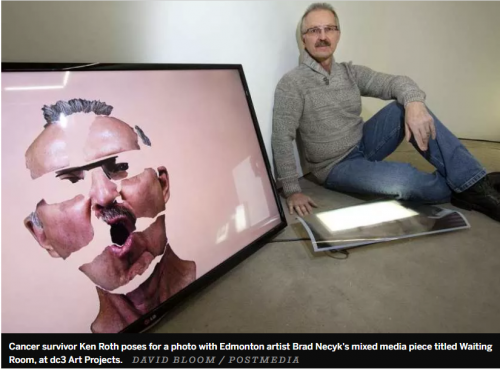Source: edmontonjournal.com
Author: Madeleine Cummings
Few words are as terrifying as these three: “You have cancer.”
“When you’re told you have cancer, everything seems to fall apart,” said Ken Roth, who was diagnosed with squamous cell carcinoma on the base of his tongue four years ago.
“Your head’s spinning, you don’t know what’s going on, you don’t know what the results are going to be,” he said.
Brad Necyk, an artist and PhD student in psychiatry at the University of Alberta, tried to capture some of that disorientation in an installation that features a fragmented video of Roth’s face.
His art is part of a new multimedia exhibition called “FLUX: Responding to Head and Neck Cancer,” which explores how head and neck cancer affects patients’ lives. (Ingrid Bachmann, Sean Caulfield, Jude Griebel, Jill Ho-You and Heather Huston also have works in the exhibit.)
Roth had three-quarters of the base of his tongue removed and his illness led him to leave his job, but others have it a lot worse, he said.
Patients with head and neck cancer often undergo lengthy (sometimes multiple) surgeries and they can have trouble speaking, swallowing and hearing. Some patients have to relearn how to speak, and then do it again after an additional surgery.
These symptoms — many of which are visible — change how patients eat, communicate and behave in public. They can be devastating, and according to the Canadian Cancer Society, depression is common among the thousands of Canadians who have these kinds of cancer.
Minn Yoon, a U of A professor who has been interviewing head and neck cancer patients for her research on oral health and the illness experience, said she felt compelled to share their stories beyond academia.
Typically, researchers publish their findings in academic journals or present them to other experts at conferences, but Yoon said she didn’t think that alone would do them justice. “I wanted to find a way of sharing their stories without losing the person behind them,” she said.
She and Pamela Brett-MacLean, a professor who directs the Arts and Humanities in Health and Medicine Program at the university, led an interdisciplinary project that brought together artists, patients and researchers.
Patients collaborated with artists during multiple workshops and feedback sessions. According to Roth, these sessions could be very emotional and stressful, but also enlightening for patients, who learned about the progression of others’ cancer treatments and exchanged advice.
Lianne McTavish, a professor who curated the exhibit and attended the workshops, said she was struck by many of the stories she heard about surgeries.
“If you have a surgery that changes your appearance significantly, your entire identity is changed and the way you function in public spaces forever is changed,” she said.
One sculpture, “Obstruction,” by Griebel, combines the catastrophe of facing a cancer diagnosis with the deadly 1903 rock slide that occurred in Frank, Alta. There is hope in the piece, however, McTavish noted. The sculpted figure appears to be sitting on a hospital bed and his body is crumbling, but he sits upright and is made of stone. Tiny trees sprout up and down his arms, suggesting recovery and care.
Necyk, the artist whose video installation portrays patients’ faces in a more intimate way, said he was nervous to show the first versions of his art to the patients with whom he worked.
“It was brutal-looking work, almost violent,” he said. “But the patients felt that this is something that’s not represented in a lot of the narrative representations we have of cancer.”
Rather than portray Roth as a hero or a victim, the art reveals how cancer can change a person, for better and for worse.


Leave A Comment
You must be logged in to post a comment.